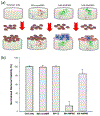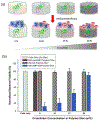Antimicrobial Peptide-Polymer Conjugates for Dentistry
- PMID: 33834166
- PMCID: PMC8026165
- DOI: 10.1021/acsapm.9b00921
Antimicrobial Peptide-Polymer Conjugates for Dentistry
Abstract
Bacterial adhesion and growth at the composite/adhesive/tooth interface remain the primary cause of dental composite restoration failure. Early colonizers, including Streptococcus mutans, play a critical role in the formation of dental caries by creating an environment that reduces the adhesive's integrity. Subsequently, other bacterial species, biofilm formation, and lactic acid from S. mutans demineralize the adjoining tooth. Because of their broad spectrum of antibacterial activity and low risk for antibiotic resistance, antimicrobial peptides (AMPs) have received significant attention to prevent bacterial biofilms. Harnessing the potential of AMPs is still very limited in dentistry-a few studies have explored peptide-enabled antimicrobial adhesive copolymer systems using mainly nonspecific adsorption. In the current investigation, to avoid limitations from nonspecific adsorption and to prevent potential peptide leakage out of the resin, we conjugated an AMP with a commonly used monomer for dental adhesive formulation. To tailor the flexibility between the peptide and the resin material, we designed two different spacer domains. The spacer-integrated antimicrobial peptides were conjugated to methacrylate (MA), and the resulting MA-AMP monomers were next copolymerized into dental adhesives as AMP-polymer conjugates. The resulting bioactivity of the polymethacrylate-based AMP conjugated matrix activity was investigated. The antimicrobial peptide conjugated to the resin matrix demonstrated significant antimicrobial activity against S. mutans. Secondary structure analyses of conjugated peptides were applied to understand the activity differential. When mechanical properties of the adhesive system were investigated with respect to AMP and cross-linking concentration, resulting AMP-polymer conjugates maintained higher compressive moduli compared to hydrogel analogues including polyHEMA. Overall, our result provides a robust approach to develop a fine-tuned bioenabled peptide adhesive system with improved mechanical properties and antimicrobial activity. The results of this study represent a critical step toward the development of peptide-conjugated dentin adhesives for treatment of secondary caries and the enhanced durability of dental composite restorations.
Keywords: Streptococcus mutans; antimicrobial peptide; bioactivity; bioconjugation; dental adhesive; mechanical property.
Conflict of interest statement
The authors declare no competing financial interest.
Figures





Similar articles
-
Reconfigurable Dual Peptide Tethered Polymer System Offers a Synergistic Solution for Next Generation Dental Adhesives.Int J Mol Sci. 2021 Jun 18;22(12):6552. doi: 10.3390/ijms22126552. Int J Mol Sci. 2021. PMID: 34207218 Free PMC article.
-
The role of adhesive materials and oral biofilm in the failure of adhesive resin restorations.Am J Dent. 2017 Oct;30(5):285-292. Am J Dent. 2017. PMID: 29178733 Review.
-
Effect of methacrylated chitosan incorporated in experimental composite and adhesive on mechanical properties and biofilm formation.Eur J Oral Sci. 2019 Feb;127(1):81-88. doi: 10.1111/eos.12584. Epub 2018 Nov 9. Eur J Oral Sci. 2019. PMID: 30412313
-
pH-Responsive Antibacterial Resin Adhesives for Secondary Caries Inhibition.J Dent Res. 2020 Nov;99(12):1368-1376. doi: 10.1177/0022034520936639. Epub 2020 Jun 29. J Dent Res. 2020. PMID: 32600095
-
Bioinspired multifunctional adhesive system for next generation bio-additively designed dental restorations.J Mech Behav Biomed Mater. 2021 Jan;113:104135. doi: 10.1016/j.jmbbm.2020.104135. Epub 2020 Oct 10. J Mech Behav Biomed Mater. 2021. PMID: 33160267 Free PMC article. Review.
Cited by
-
A review on small molecular mimics of antimicrobial peptides with an emphasis on the structure-activity relationship perspective.RSC Med Chem. 2025 Jun 24. doi: 10.1039/d5md00407a. Online ahead of print. RSC Med Chem. 2025. PMID: 40656837 Free PMC article. Review.
-
Harnessing biomolecules for bioinspired dental biomaterials.J Mater Chem B. 2020 Oct 14;8(38):8713-8747. doi: 10.1039/d0tb01456g. Epub 2020 Aug 4. J Mater Chem B. 2020. PMID: 32747882 Free PMC article. Review.
-
Recent Advances in Antimicrobial Peptide Hydrogels.Int J Mol Sci. 2023 Apr 20;24(8):7563. doi: 10.3390/ijms24087563. Int J Mol Sci. 2023. PMID: 37108725 Free PMC article. Review.
-
Nanohybrids as Protein-Polymer Conjugate Multimodal Therapeutics.Front Med Technol. 2021 Sep 8;3:676025. doi: 10.3389/fmedt.2021.676025. eCollection 2021. Front Med Technol. 2021. PMID: 35047929 Free PMC article. Review.
-
Shaping the Future of Antimicrobial Therapy: Harnessing the Power of Antimicrobial Peptides in Biomedical Applications.J Funct Biomater. 2023 Nov 2;14(11):539. doi: 10.3390/jfb14110539. J Funct Biomater. 2023. PMID: 37998108 Free PMC article. Review.
References
-
- Delaviz Y; Finer Y; Santerre JP Biodegradation of Resin Composites and Adhesives by Oral Bacteria and Saliva: A Rationale for New Material Designs that Consider the Clinical Environment and Treatment Challenges. Dent. Mater 2014, 30 (1), 16–32. - PubMed
-
- Moszner N; Hirt T New Polymer-Chemical Developments in Clinical Dental Polymer Materials: Enamel—Dentin Adhesives and Restorative Composites. J. Polym. Sci., Part A: Polym. Chem 2012, 50 (21), 4369–4402.
-
- Santerre J; Shajii L; Leung B Relation of Dental Composite Formulations to Their Degradation and the Release of Hydrolyzed Polymeric-Resin-Derived Products. Crit. Rev. Oral Biol. Med 2001, 12 (2), 136–151. - PubMed
-
- Rho YJ; Namgung C; Jin BH; Lim BS; Cho BH Longevity of Direct Restorations in Stress-Bearing Posterior Cavities: A Retrospective Study. Oper. Dent 2013, 38 (6), 572–82. - PubMed
-
- Bernardo M; Luis H; Martin MD; Leroux BG; Rue T; Leitao J; DeRouen TA Survival and Reasons for Failure of Amalgam versus Composite Posterior Restorations Placed in a Randomized Clinical Trial. J. Am. Dent. Assoc., JADA 2007, 138 (6), 775–783. - PubMed
Grants and funding
LinkOut - more resources
Full Text Sources

